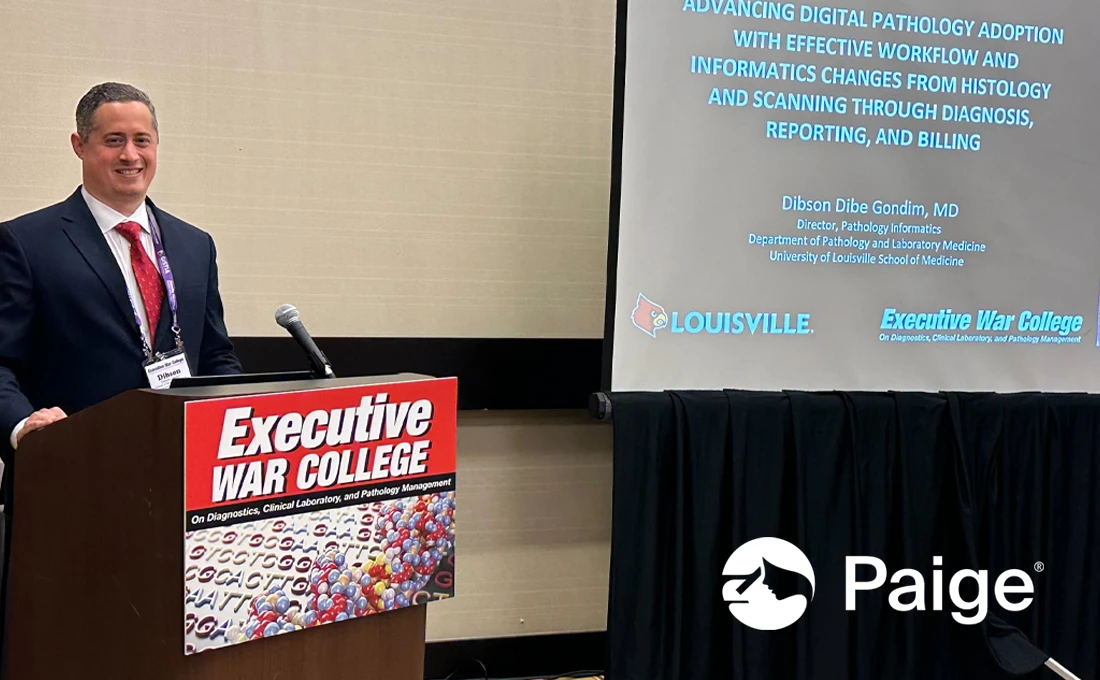Dr. Dibson Gondim, Director of Pathology Informatics at the University of Louisville, shared key factors that enabled his lab to complete a digital transformation in less than 1 year at the 2023 Executive War College. Gondim was asked to speak on his recent success and provide other labs with a toolkit for digital pathology implementation and adoption, both of which he said hinge on one very important decision; selecting an interoperable digital pathology platform.
An interoperable platform connects all of a lab’s chosen vendors within one seamless workflow. This not only ensures that the platform is functional and valuable for day-to-day pathology work, but dramatically streamlines what can otherwise be a complex implementation and adoption process. To illustrate this, Dr. Gondim walked through each step in his experience of going digital, sharing the guiding principles that informed his decision making and what considerations other labs should keep in mind.
He explained that pathology labs must first decide what they’re hoping to gain from digital pathology. In the case of the University of Louisville, which has pathologists at 3 locations providing services for a larger network of clinics and hospitals, the aim was to tap into the efficiency gains simplified case sharing and communication can offer. Additionally, they wanted to enable their pathologists to utilize clinical-grade AI tools, which can help enhance diagnostic confidence. Importantly, they were looking to achieve a complete transfer to digital within 9 months, rather than taking a phased approach.
With these goals laid out, labs can then define what is needed to make them a reality. For Dr. Gondim, learnings from market research and some previous experience with digital pathology helped inform these requirements. In his first experience with digital pathology, the scanner being in an inconvenient place, limited access to scanner files, and clunky integration between the digital platform and his LIS made the technology quite impractical. This time, avoiding those pitfalls was the highest priority.
On top of that, the goal of full digital implementation, meaning 100% of their slides scanned, in 9 months meant they’d need quality high-volume scanners and robust storage. Their desire to use AI also meant they’d need a cloud-based, remote-accessible slide viewer along with access to FDA-approved AI software fit for use on real patients. Most importantly, Dr. Gondim emphasized, they’d need to be able to connect each of these elements. While every lab’s requirements may not exactly match University of Louisville’s, complete interoperability between the scanner, viewer, AI applications, and LIS will always be paramount to ensuring pathologists can successfully employ digital pathology in regular practice.
The Paige Platform is a completely open solution that supports nearly unlimited integration options with scanners, LIS, AI applications, and beyond. This, as well as the fact that Paige offers the only FDA-approved AI in pathology today*, is web-based and scalable, and even allows for deployment of in-house AI through UnifAI, Paige’s SDK, made Paige the right choice for the University of Louisville. Now the next challenge to tackle, Dr. Gondim explained, became implementation.
Once the correct vendors have been found, the lab must clearly lay out who will be involved in implementation, what their role will be, and what the steps will entail. Here, there are 3 key things to keep in mind: First, implementation is a stepwise process. Labs should start by adjusting slide processing protocols and introducing scanners, then connecting the scanners to the new viewer, and only then adding AI functionality; each step must build upon the last for the implementation to be successful. Secondly, Dr. Gondim reminded the audience that the chosen vendors must be fully open technologically and also practically. They may need to work together to create updated interfaces or enable communication between their two systems, and their willingness to do so is the only way to ensure the tools are implemented into one workflow properly. Finally, he urged labs to consider vendors that will work directly with them throughout the implementation process. Every lab is different in terms of their in-house resources and bandwidth, and being able to work side-by-side with vendors to customize each phase to the lab’s needs will eliminate any setbacks or mistakes.
Only once all of these steps are complete can pathologists really begin to see transformation taking shape in the lab. Still, adoption comes with its own set of challenges. Digital pathology is a totally new way of working for many pathologists, and it will be critical to work with the chosen vendors to effectively train the team on how to employ their new systems without productivity gaps. To that end, if the systems chosen are not interconnected onto one platform, this challenge becomes much more complex. Dr. Gondim shared that labs will need to aim for optimal interoperability to ensure that the use of digital pathology is easier and more efficient than the use of traditional pathology workflows, or pathologists will be hesitant to adopt the new process.
However, so long as this challenge has been accounted for, digital pathology offers unparalleled benefits for pathologists, including an improved tumor board experience, efficient intradepartmental consultation, and of course, ability to use AI to improve diagnostic efficiency and confidence. In fact, these are just a few of the benefits University of Louisville has realized since their introduction of the Paige Platform and Paige AI. So, while the process of digitization can be somewhat complex, Dr. Gondim urges labs to take the leap. Pathologists and the entire downstream cancer care team will only stand to benefit.
* In the United States, Paige Prostate Detect (DEN200080) is approved for clinical use with Philips Ultrafast Scanner.

